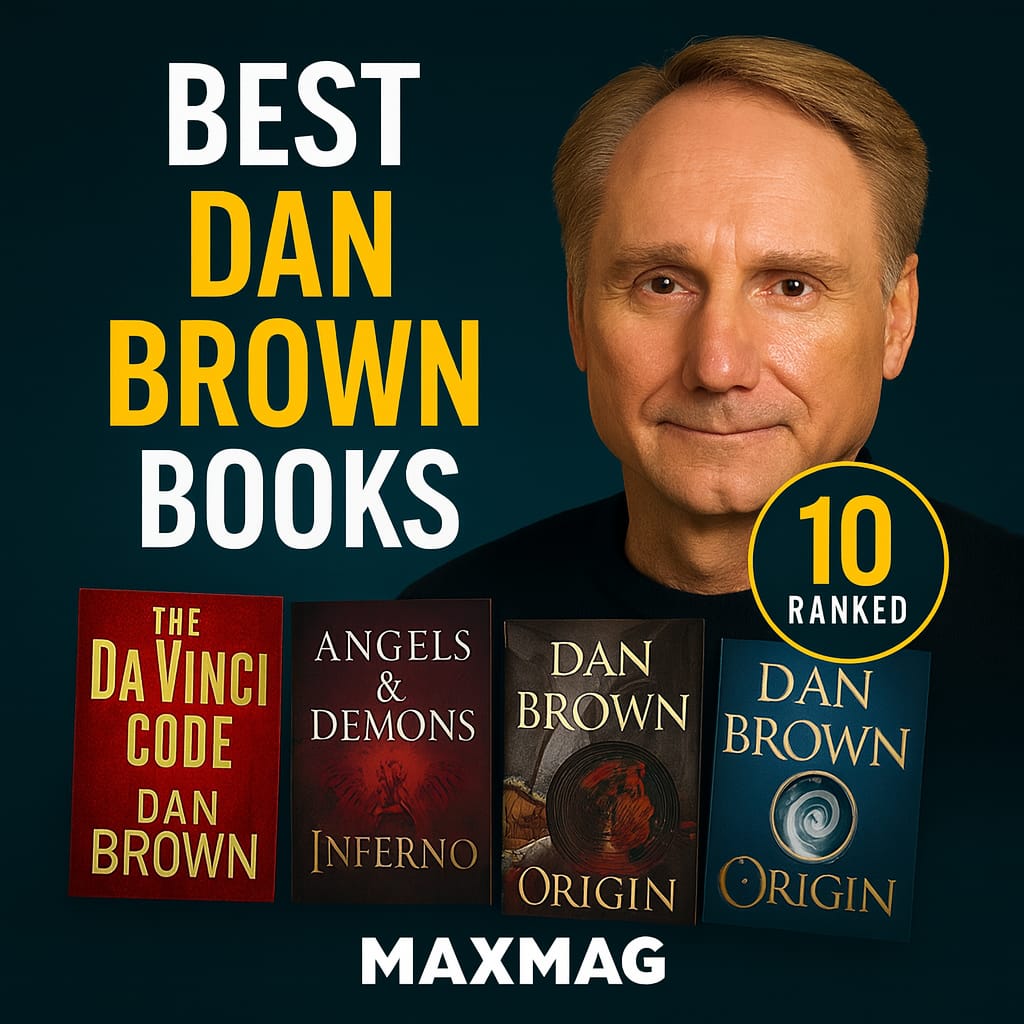
From Exeter, New Hampshire, Brown’s Best Dan Brown Books defined the code-driven thriller for a global audience. His full name is Daniel Gerhard Brown, an American novelist who works in conspiracy-tinged mysteries and techno-thrillers. He is commonly associated with Harvard symbologist Robert Langdon and globe-spanning puzzle chases. Signature titles include The Da Vinci Code and Angels & Demons. His career spans the late 1990s to the present, with novels, a children’s picture book, and an all-new Langdon entry in 2025. The settings range from Seville and Vatican City to Washington, Florence, Barcelona, Prague and beyond. The subjects mingle cryptography, art history, religion, and emerging science. Brown’s commercial footprint includes multi-million copy sales and translations across dozens of languages.
His breakout was The Da Vinci Code, the title that vaulted him into global bestseller territory; later, Origin extended the Langdon arc before a 2025 return with The Secret of Secrets. These novels turn on recurring motifs—hidden orders, museum clues, manuscripts in peril, and timed chases through famous cities. Readers keep returning for the riddles, the recognizable landmarks, and the brisk momentum. This ranked guide includes 10 works that meet the threshold. It is sequenced in rising rating order; ties by year, then title. The selection focuses on primary books written by Brown, including a YA adaptation and a picture book with strong reader consensus. The objective is to surface the shape of a career through a ratings-led climb to consensus highlights.
10 Best Dan Brown Books in a Rising Rating Order
Methodology & Updates
Sources: Goodreads title pages and the author’s works list captured on October 21, 2025; placements follow average reader ratings with a ≥3.0 threshold and ties broken by earlier year, then A–Z title; this means Best Dan Brown Books positions may shift as new ratings accrue.
#1) Digital Fortress – 1998
- Author: Dan Brown
- Published: 1998
- Work Type / Genre Tags: novel, techno-thriller, cryptography
- Themes: privacy, surveillance, secrecy
- Goodreads Rating: 3.70/5
At the NSA’s Fort Meade and in Seville, cryptographer Susan Fletcher and linguist David Becker are introduced. A supposedly unbreakable code stalls the agency’s massive decryption engine and triggers an internal crisis. Susan must determine whether the algorithm is a genuine breakthrough or a trap that could cripple national security. Becker is sent to Spain to retrieve a key, drawing him into a chain of street-level dangers. Clues splinter between the agency floor and European backstreets as rivals close in. Each discovery suggests a deeper layer of misdirection with international stakes. The endgame races toward a system-threatening release that only a precise interpretive leap can stop. A final deciphering move defines the consequence for both the code and its makers.
#2) Deception Point – 2001
- Author: Dan Brown
- Published: 2001
- Work Type / Genre Tags: novel, techno-thriller, political conspiracy
- Themes: science vs politics, evidence, trust
- Goodreads Rating: 3.76/5
On Arctic ice near the Milne Ice Shelf, White House intelligence analyst Rachel Sexton joins a NASA team unveiling a meteorite with startling biological implications. The find sparks a clash over funding and credibility as a presidential race looms. Rachel must verify the discovery while weighing the political consequences. Relationships among scientists, intelligence contractors, and the military fray as anomalies surface. Deadly intervention by covert operators forces improvised escapes across lethal terrain. Each forensic check alters the risk calculus and hints at layered fabrication. A final exposure threatens careers and security alike without spelling out every conspirator. The outcome reorders who controls the narrative and why the evidence mattered.
#3) The Lost Symbol – 2009
- Author: Dan Brown
- Published: 2009
- Work Type / Genre Tags: novel, thriller, Robert Langdon
- Themes: initiation, knowledge, brotherhood
- Goodreads Rating: 3.76/5
In Washington, D.C., symbologist Robert Langdon arrives for an evening event and is confronted with a grotesque sign that signals a crisis. A kidnapping forces him to chase clues embedded in national landmarks. His immediate objective is to decode a pyramid and protect a friend tied to the mystery. Tensions sharpen around Masonic history and a secretive research lab exploring noetics, drawing competing agendas into the hunt (Freemasonry). Mid-story breakthroughs connect Renaissance symbols to Capitol geography and hidden chambers. Each step raises stakes as the antagonist’s fixation becomes clearer. The path toward a climactic chamber is charted without disclosing the chamber’s content. The consequence lands on what kind of knowledge a democracy safeguards.
#4) Inferno – 2013
- Author: Dan Brown
- Published: 2013
- Work Type / Genre Tags: novel, thriller, Robert Langdon
- Themes: population, plague risk, art and literature
- Goodreads Rating: 3.90/5
In Florence, Robert Langdon wakes in a hospital with partial amnesia and a macabre object tied to Dante. A pursuer turns the city into a maze as bodies of knowledge point to catastrophic intent. Langdon must decipher literary and artistic clues fast enough to locate a biothreat. Alliances form and fracture with a doctor who becomes his principal ally. Midway, iconography and lines from the Divine Comedy redirect the search through museums and cathedrals. Each reveal compresses the timeline and reframes who is controlling the outcome. The final sprint heads toward containment or release without naming the mechanism. The story closes on a consequence measured in human numbers.
#5) Origin – 2017
- Author: Dan Brown
- Published: 2017
- Work Type / Genre Tags: novel, thriller, Robert Langdon
- Themes: science vs faith, AI, futurism
- Goodreads Rating: 3.90/5
At Bilbao’s Guggenheim Museum, a tech futurist prepares to unveil a discovery addressing humanity’s oldest questions. An attack aborts the reveal and sends Robert Langdon and a museum director across Spain. They must retrieve a passworded presentation while avoiding multiple security services. Clues route them through Gaudí’s landmarks and a modern basilica whose design choices matter (Sagrada Família). Mid-story, an AI assistant reframes what the protagonists can trust. The stakes rise as competing factions try to control dissemination. A finale approaches where the reveal’s implications matter more than spectacle. The endpoint lands on the consequence of knowledge made public.

#6) The Da Vinci Code – 2003
- Author: Dan Brown
- Published: 2003
- Work Type / Genre Tags: novel, thriller, Robert Langdon
- Themes: secrecy, art history, religious lore
- Goodreads Rating: 3.93/5
In Paris, a Louvre curator’s murder draws Robert Langdon and cryptologist Sophie Neveu into a trail of symbols. A hidden message points them toward an encoded quest. Their immediate objective is to interpret clues before a powerful faction silences them. The duo’s alliances and family ties complicate the chase as the itinerary shifts to London and beyond (Louvre Museum). Midway, word puzzles and art details narrow possible repositories. Every step accelerates a deadline imposed by law enforcement and shadowed adversaries. The climax trajectory aims at a sanctuary with layered historical claims. The endpoint hinges on a choice about revelation versus protection.
#7) Angels & Demons – 2000
- Author: Dan Brown
- Published: 2000
- Work Type / Genre Tags: novel, thriller, Robert Langdon
- Themes: science vs religion, succession, secrecy
- Goodreads Rating: 3.95/5
At CERN and in Rome, a physicist’s death and missing antimatter set Robert Langdon on a chase tied to conclave politics. The inciting event threatens both the Vatican and a scientific facility. Langdon’s objective is to follow a pathway through Bernini works to prevent timed killings. Tensions rise between church security, Swiss Guards, and outside forces as sites across the city become stages (CERN). Mid-story clues recontextualize a centuries-old adversary and a modern infiltrator. The schedule tightens as each marker is reached. The trajectory points toward a final confrontation within sacred precincts. The outcome leaves a public narrative and a private truth.
#8) The Secret of Secrets – 2025
- Author: Dan Brown
- Published: 2025
- Work Type / Genre Tags: novel, thriller, Robert Langdon
- Themes: consciousness, manuscripts, pursuit
- Goodreads Rating: 4.02/5
In Prague, Robert Langdon arrives for a lecture linked to noetic scientist Katherine Solomon. A murder at the venue propels him into a search for Katherine, who vanishes with a crucial manuscript. His objective is to reconstruct her work and find her before a powerful organization does. Relationships with local scholars and security services shift as a figure from Prague’s folklore stalks the trail. Midway, clues redirect the hunt to London and New York, where the project’s scope widens. Each step suggests the manuscript challenges accepted ideas about the mind. The climax trajectory forms around whether the research can be suppressed or released. The closing consequence turns on who controls a discovery that could recast human self-understanding.
Momentum Builds…
#9) Wild Symphony – 2020
- Author: Dan Brown
- Published: 2020
- Work Type / Genre Tags: picture book, children’s, poetry
- Themes: music, nature, pattern
- Goodreads Rating: 4.30/5
Across forests, seas, and fields, Maestro Mouse introduces animal friends in brief, rhymed vignettes. A gentle prompt sets the journey’s structure as each creature offers a small lesson. The objective is to follow a sequence that hides a simple coded message. Relationships between verses and illustrations guide page turns and small reveals. Mid-story, recurring motifs suggest how clues assemble. The stakes are low but purposeful as the puzzle invites attention and play. The penultimate spread foreshadows the message’s key. The endpoint is a decoded line that ties music, movement, and noticing together.
#10) The Da Vinci Code: The Young Adult Adaptation – 2016
- Author: Dan Brown
- Published: 2016
- Work Type / Genre Tags: young adult adaptation, thriller, Robert Langdon
- Themes: secrecy, codebreaking, heritage
- Goodreads Rating: 4.50/5
In a streamlined Paris-to-London chase, Robert Langdon teams with Sophie Neveu after a museum murder. A cipher and a sequence of art clues launch a compressed itinerary. Their immediate objective is to unlock a message before a pursuing faction does. Family history and institutional pressure complicate who is safe to trust. Mid-story puzzles across churches and archives narrow the search. Each decoded step increases urgency and shortens options. The trajectory heads toward a sanctuary with a withheld answer. The endpoint implies a guarded truth rather than an exposed spectacle.
Dan Brown: Career at a Glance
Daniel Gerhard Brown (b. 1964, Exeter, New Hampshire) moved from music to fiction in the late 1990s and became a defining figure in the modern conspiracy thriller, often shaping discussions of Best Dan Brown Books. Working primarily in the novel form, he built the Robert Langdon series (Angels & Demons, The Da Vinci Code, The Lost Symbol, Inferno, Origin, The Secret of Secrets) while also writing standalones (Digital Fortress, Deception Point) and a children’s picture book (Wild Symphony). His innovations include puzzle-led plotting through art, architecture, and science, and a recurring 24-hour clock that compresses action. Film and TV adaptations extended the reach of Langdon’s world. Recognition includes sustained bestseller status and global translations. His influence shows in campus courses on popular culture, in museum programming, and in a generation of thriller writers who adopted code-and-artifact storytelling.
Conclusion
This guide gathered 10 works across 1998–2025, revealing early techno-thrillers, the establishment of the Langdon cycle, and later returns that broaden the canvas; at a glance, the ordering shows how deep cuts give way to consensus high points in Best Dan Brown Books. For authoritative biographical context and publication history, see the author’s entry at Encyclopaedia Britannica.
Across the list, recurring structures include time-boxed pursuits, map-and-museum routes, and puzzles that hinge on art, ritual, and technology—patterns that help explain the ongoing readership for Best Dan Brown Books. For a journalism-led overview of Brown’s cultural footprint, consider TIME’s profile placing him on the magazine’s influential roster during the Da Vinci wave (TIME).
FAQ: What to know about the Best Dan Brown Books
Q1: What counts toward the Best Dan Brown Books ranking here?
Q2: Why do Langdon titles dominate most Best Dan Brown Books lists?
Q3: How did you break ties in the Best Dan Brown Books ordering?
Q4: Are illustrated or omnibus editions part of the Best Dan Brown Books?
Q5: Will a new release change the Best Dan Brown Books lineup?




